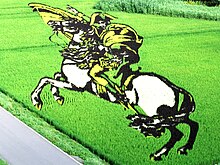Rice paddy art

Rice paddy art or tambo art (田んぼアート, tanbo āto) is an art form originating in Japan where people plant rice of various types and colors to create images in a paddy field.[1][2]
History

In 1993, the people of Inakadate, in Aomori Prefecture, were looking for a way to revitalize their village. Archaeological exploration led to a realization that rice had been grown in the area for more than 2000 years.[3] To honor this history, the villagers started a rice field behind the town hall. With the paddy as a canvas, the villagers cultivated and used four different types[3] of heirloom and modern strains of rice to create a giant picture in the field. To allow viewing of the whole picture, a mock castle tower 22 meters high was erected at the village office.[3] In 2006, more than 200,000 people visited the village to see the art.[3]
Another observation tower was built looking down the Tambo art location 2 at Michi no eki Inakadate nicknamed “Yayoi no sato”[4] or a village of prehistoric Yayoi period. Both places charge admission fees, while visitors are encouraged to take bus serving both location 1 and 2 to avoid traffic jam.[4] In August 2015, a video camera was installed for both locations and started live stream the art,[5] and they were registered on Google Street View the same year.[6] A winter campaign since 2016 has been held on location 2 with instruction initially by snow artist Simon Beck.[7]
For the first nine years, the farmers created a simple picture of Mount Iwaki[8] before going to more complex designs.
Following Inakadate's example, other villages such as Yonezawa in Yamagata prefecture have started to create their own tambo art.[8]
Inakadate designs

The following is a list of the designs that have been used in the Inakadate pictures.
- 2003 – Leonardo da Vinci, "Mona Lisa"
- 2004 – Shikō Munakata – "Two Bodhisattvas and Ten Great Disciples of Shakamuni Buddha" and "Queen Mountain God"
- 2005 – Sharaku – "Otani Oniji", Utamaro – "Anthology of Poems: The Love Section"
- 2006 – Tawaraya Sōtatsu – "Fujin and Raijin"
- 2007 – Hokusai – from Thirty-six Views of Mount Fuji: "The Great Wave off Kanagawa" and "South Wind, Clear Sky"
- 2008 – Ebisu, Daikokuten
- 2009 – Sengoku military commanders, Napoleon
- 2010 – Heian period military commanders involved in Siege of Koromogawa, Minamoto no Yoshitsune and Benkei
- 2011 – The Tale of the Bamboo Cutter
- 2012 - Kano Hogai - "Hibo Kannon ('Kannon the Merciful Mother') and Acala": the Seven Lucky Gods
- 2013 - Geisha and Marilyn Monroe, Ultraman
- 2014 - Swan maiden, Mount Fuji and Sazae-san
- 2015 - Gone With the Wind, Star Wars[4]
- 2016 - Shin Godzilla,[9] Ishida Mitsunari and Sanada Masayuki from “Sanadamaru”, a 2016 Japanese drama for NHK[4]
- 2017 - Yamata no Orochi against Susanoo-no-mikoto, Momotarō[4]
- 2018 - Roman Holiday, Osamu Tezuka, the illustrator of Astro Boy
Production
Every April, the villagers meet and decide what to plant for the year.[3] Prior to planting, farmers sketch out the designs on computers to figure out where and how to plant the rice.[8] In 2007, 700 people helped plant rice.[3] Agreements between landowners have allowed for larger pictures to be created.
Advertising controversy
In 2008, it was planned to change the lower part of the field to include the logos of Japan Airlines and To-o Nippo, a local newspaper, for a reported 2 million yen to offset increased costs. The members of the local landowners' organization, along with the former mayor, protested, saying that the land would not be leased from the following year if the plan to display advertising logos was not abandoned. The village revitalization group voted by a narrow margin not to include the advertisements, and the seedlings that were planted were removed.[10][11][12]
See also
- Tamboāto Station, a railway station built specially to serve an area famous for rice paddy art in Inakadate, Aomori
- Hill figure
- Nazca Lines
- Crop circle
References
- ^ Fackler, Martin (2010-07-15). "Japanese Village Creates Art From Hues of Rice". The New York Times. Retrieved 2013-09-10.
- ^ Bekku, Junichi (2012-08-19). "'Rice paddy art' reaches new heights of sophistication". The Asahi Shimbun. Archived from the original on 2012-08-22. Retrieved 2013-09-10.
- ^ a b c d e f Hani, Yoko (2007-08-26). "Homegrown art". The Japan Times. Retrieved 2010-02-22.
- ^ a b c d e "The visitors' guide to tambo art" (in Japanese). Office of Inakadate, Aomori. Retrieved 2018-01-17.
- ^ "Tambo Art has its website now" (in Japanese). Inakadate, Aomori. 2015-08-05. Archived from the original on 2017-12-21. Retrieved 2018-01-17.
- ^ "Tambo art is on Google Street View" (in Japanese). Inakadate Village. 2015-10-19. Retrieved 2018-01-17.
- ^ "Winter tambo art 2018 will be held" (in Japanese). Inakadate Village. 2018-01-15. Archived from the original on 2018-01-17. Retrieved 2018-01-17.
- ^ a b c "Farmers create coloured rice 'murals' in Japan". Telegraph. August 3, 2009. Retrieved 22 February 2010.
- ^ Baseel, Casey (2016-07-16). "Godzilla appears in Aomori Pref as rice paddy art". RocketNews24. Retrieved 2018-01-17.
- ^ 田んぼアート、広告いらない 地権者抗議で苗抜き取り – Asahi Shimbun, 4 July 2008
- ^ 田んぼアートの広告削除へ Archived 2008-07-07 at the Wayback Machine – Too Nippo, 4 July 2008
- ^ 田んぼアート もったいない? 企業広告絵柄を抜き取り[permanent dead link] – Mainichi Shimbun, 5 July 2008
